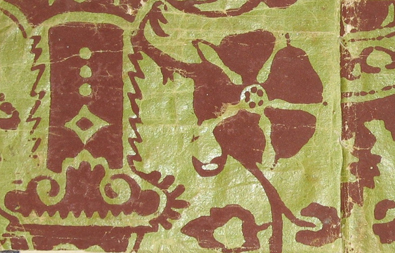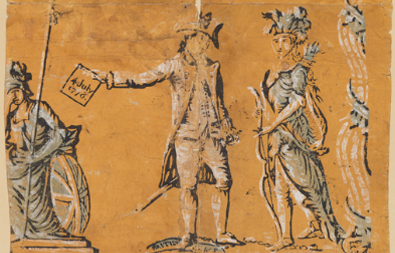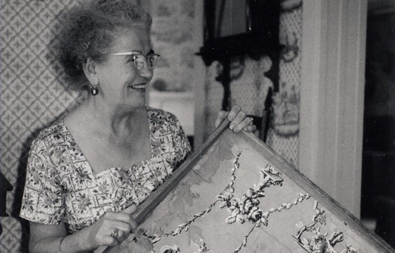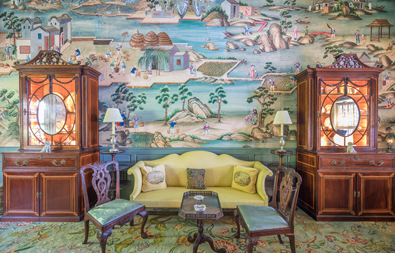American manufacturers were proud of their domestically produced goods. The billhead of Appleton Prentiss boasts an image of the American eagle and the words “AMERICAN MANUFACTURE” above rolls of different patterns he made. Many of these patterns can be identified in Historic New England’s collection.
Wallpapers by several other New England paper strainers are also included in Historic New England’s collection. Ebenezer Clough established his paper staining business in Boston in 1795. An advertisement dated the next year lists patterns “of every description both large and small” in addition to many colors of “plain papers,” solid-colored rolls to be used with borders.
Clough is best known for the commemorative paper of George Washington he advertised less than one year after Washington’s death in 1799. Based on a variation of the pillar and arch design, “Washington’s Monument” includes classical motifs and allegorical figures of Justice and Liberty weeping over the loss of the national hero.
Moses Grant, who participated in the Boston Tea Party, became a successful upholsterer and wallpaper manufacturer. His son, Moses Jr., was equally successful. A number of patterns bearing his stamp have been found throughout New England. Many wallpaper manufacturers probably stamped their name on the ends of rolls, but because this portion was usually cut off during installation, stamps like the one Moses Grant Jr. used are relatively rare. The pattern is one of many similar designs created by the Grant firm using interchangeable blocks.
Zechariah Mills, (1770-1851) a Hartford, Connecticut, wallpaper manufacturer and dealer, sold his own papers and those he imported from Philadelphia, Baltimore, New York, and Boston. Mills is credited with being the first New England wallpaper manufacturer to routinely stamp and number his papers to protect his own designs.
A documented Mills paper in Historic New England’s collection is a stripe design composed of vertical rows of wheat printed in varnish green alternating with wide stripes of flowered vines. Though the pattern appears to be a simple two-color design, it is in fact fairly complex. A fine white vine and pinstripe design, now faded, originally formed an all-over background pattern on the slate blue ground color.
Mills’ stripe paper was one of the many “neat stripes, vines, and set figures” available to consumers in the beginning years of the nineteenth century. Also popular were a variety of small geometric patterns that were available in several different color schemes. American-made wallpapers did not entirely displace fine English wallpapers, especially on the upper end of the market. Samples of ten English wallpapers purchased by lawyer Harrison Gray Otis for the elegant three-story Federal-style mansion he and his wife were building in Boston in 1797 were uncovered during restoration in 1920. Many have been reproduced and can be seen in the Otis House Museum today.
Ten years later, Portsmouth, New Hampshire, merchant James Rundlet ordered seven different wallpaper patterns and complimentary borders directly from London. Rundlet kept detailed accounts of the building expenses for his impressive three-story house. Of the total construction cost of $12,604.47, approximately $283 was spent on 112 rolls of wallpaper. The paper and border identified as “Peach Damask” and “Paris Flock Border” on the shipping invoice were hung in the best parlor in 1809 and remain on the walls today.
Competition from France increases: Beginning in the late 1780s there was a dramatic increase in imported French wallpapers and, indeed, French wallpapers and their American copies set the style for the next seventy-five years. In 1787, the French eliminated export duties on wallpaper and thereby lowered the cost of purchasing this luxury item. Cost was not the only factor that contributed to the increased use of French papers in New England. French wallpaper firms produced the highest quality and most artfully designed and colorful wallpapers of this period.
Manufacturers like Jean-Baptiste Reveillon (1725-1811) refined the process of printing with wooden blocks and distemper paints, and raised wallpaper manufacturing to new artistic heights. Reveillon created a vast workshop of more than three hundred craftsmen and divided the labor into specific and repetitive tasks. He ground his own pigments and in 1767 purchased a paper mill where he was able to control the quality of the paper used to make up rolls of wallpaper.
Reveillon employed the finest designers and engravers who were well versed in the neoclassical vocabulary of ornament derived from archaeological discoveries at Pompeii and Herculaneum. Several of Reveillon’s arabesque designs survive on the walls of New England houses, most notably in Phelps-Hathaway House in Suffield, Connecticut.
A French arabesque paper from The Mount in Bristol, Rhode Island, features characteristics typical of Reveillon’s style. It contains mythological motifs including satyr heads, winged nymphs, scenes of Leda and the Swan, and a bacchante enclosed within an elliptical frame. The neoclassical elements are separated by garlands and arabesques printed in bright colors against a pastel colored ground. These elegant arabesque papers were particularly popular with trend-setting Americans. Thomas Jefferson was so taken with the French wallpapers he saw while he was Ambassador to France that he ordered more than 120 rolls in 1790 upon his return to Virginia.
Although many American manufacturers were quick to advertise that their products were equal in quality to imported ones and were less expensive, comparisons reveal that their claims were most often unfounded.
By the first quarter of the nineteenth century, the abundance and popularity of French wallpaper threatened the existence of many American wallpaper firms. The French excelled in creating three-dimensional modeled forms and realistic detailing in floral patterns, imitation drapery and marble masonry designs, charming landscape figure papers, flocked borders, and expensive scenic landscape papers.
The latter represent the highest achievement in French wallpaper printing and design. Composed of between twenty and forty individual panels, an entire set required thousands of blocks to produce the elaborate design. A room hung with a scenic paper became a substitute for travel as it offered a view of the great monuments of Europe or an escape to an exotic, far-away place.
One of the most popular sets of scenic paper exported by Dufour was Telemachus, also known as Les Paysages de Telemaque dans l’ile de Calypso. Based upon a 1699 French adaptation of Homer’s Odyssey by novelist Francois Fenelon (1651-1715), Les Adventures de Telemaque was immensely popular. The set, created about 1818, was printed in eighty-five colors and required more than two thousand wood blocks to print the design. The continuous scene of non-repeating panels is filled with visual delights and narrative drama, including the moment when Telemachus attempts to escape from the Island of Calypso. Andrew Jackson ordered two sets of Telemachus for the hallway of his house, the Hermitage, in Nashville, Tennessee, in the 1830s.
Innovative pattern types and techniques: Another pattern type that originated in France and was extremely popular during the early nineteenth century was called a “landscape figure.” These formulaic patterns were composed of rows of two or three repeating vignettes with pastoral or classical themes separated by vertical stripes on a dotted or diapered field. To keep pace with their French competitors, American wallpaper firms produced many adaptations of this style. Made around 1810-1815, this American landscape figure paper was used in a house near Plymouth, Massachusetts; apparently, the home owner didn’t mind that the design was misprinted.
French wallpaper manufacturers also developed relatively simple techniques for producing spectacular designs. Jean Zuber experimented with ways of applying multi-colored grounds to the papers. His cousin, Michel Spoerlin, perfected a method of blending multiple ground colors, called irise, on a single roll of paper.
In America, these were called rainbow papers. The brilliant green, pink, and yellow matte ground of this Zuber paper dating from 1825-1835 is over printed with a restrained foliate medallion pattern en grisaille.
The same blocks could be used to print the pattern on a solid or a blended background, thereby creating two totally different looking wallpapers.
In addition to all-over floral designs, striped floral patterns remained popular during the first half of the nineteenth century. Many of these small-scale designs feature stripes with stylized flower alternating with bands of Xs or dots and are printed in two or three colors. A pattern book of the Hartford, Connecticut, firm Janes & Bolles, in business between 1821 and 1828, contains five colorways of a striped pattern that relates to this variation used to line a pine trunk.
Larger-scaled medallion papers offered an alternative to the smaller striped patterns. In addition to being applied to walls, many of these medallion wallpapers can be found on band boxes—all-purpose receptacles made in several sizes and intended to hold bonnets, ribbons, and other trinkets.
Many bandboxes were hand made at home using leftovers from decorating a room. At least one enterprising woman, Hannah Davis of Jaffrey, New Hampshire, developed her own cottage industry making bandboxes as a means of supporting herself. She sold them to local shopkeepers and directly to young mill workers. She is the most well-known maker today because she applied printed labels with her name inside the lid.
Other band boxes were commercially made and sold by wallpaper manufacturers who often designed patterns to be used specifically on them. The patterns of the coach and horses, the deer, and the buildings of Yale were printed horizontally on the roll of paper and were never intended to be used on walls.

 Importing a Fashionable Commodity
Importing a Fashionable Commodity Rise of American Manufacturing, Increasing Imports
Rise of American Manufacturing, Increasing Imports Changing Technology and Increasing Production
Changing Technology and Increasing Production Profusion of Patterns
Profusion of Patterns Design for the New Century and Modern Consumer
Design for the New Century and Modern Consumer History of Reproduction Wallpapers
History of Reproduction Wallpapers Dorothy Waterhouse’s Extraordinary Collection
Dorothy Waterhouse’s Extraordinary Collection Papers from China
Papers from China
